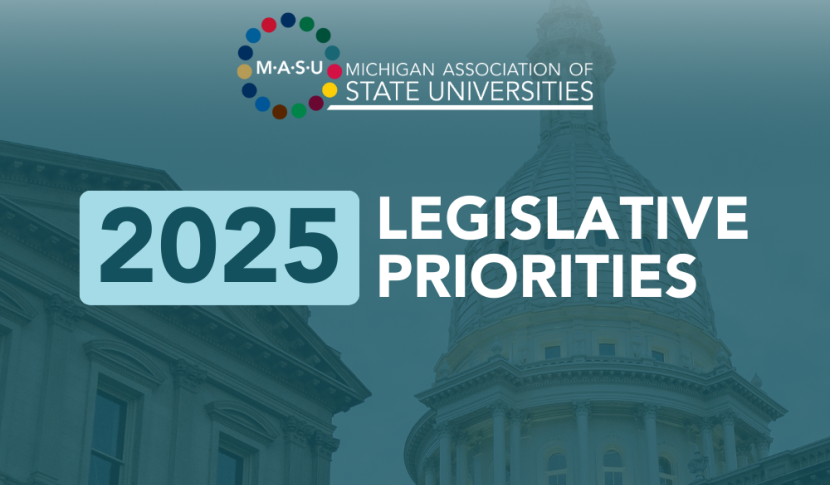2025 Legislative Priorities of the State Universities of Michigan

2025 Legislative Priorities of the State Universities of Michigan
The state universities of Michigan are indispensable public assets that positively impact virtually every aspect of society, and as such, seek to partner with state officials in the unending quest to move Michigan forward. These institutions drive state economic growth and serve as the largest suppliers to the workforce talent pipeline. Fulfilling these fundamental roles requires continued strong collaboration with the state to enhance college affordability and improve student outcomes. With the 103rd Michigan legislature underway, the Michigan Association of State Universities (MASU) looks forward to working with its member universities, state lawmakers, and the Governor and her administration to make progress on shared priorities.
For the past decade, MASU has advocated for a limited, but highly impactful set of legislative priorities that when achieved greatly improve college affordability and student success at the state’s world-class universities. While there are many factors that comprise the universities’ ability to serve the state, its residents, and the greater public interest, college access and the success of our students and graduates are among the most important tenets.
The three primary legislative priorities for 2025 are as follows:
#1: Increase State Operating Support for Public Universities to Improve College Affordability
Reinvigorating state investment to power Michigan’s workforce talent pipeline remains the universities’ top priority. A high-quality education, leading to workers with valuable and productive degrees and other credentials, requires sufficient funding from the state. And while we’ve made some progress in recent years, extensive reinvestment must occur to offset the more than $1.2 billion inflation-adjusted state funding reduction that has been witnessed over the past two decades.
Actions and Goals:
- Advocate for sustained, sufficient state funding to improve college affordability, especially for low- and middle-income students.
- Address the decline in state investment over the past two decades, which forced universities to raise tuition and shifted funding burdens onto students and families.
- Align funding levels for public universities closer to the national average, particularly in comparison to community colleges.
- Support workforce-aligned academic programs to enhance student success and strengthen Michigan’s talent pipeline.
#2: Continue the Implementation of the Michigan Achievement Scholarship to Enhance College Affordability
As a state, we need to build on Michigan’s historic investment in financial aid to ensure that less affluent students can earn a college degree. With the Michigan Achievement Scholarship (MAS), it’s a new day for college affordability in Michigan. The greatly improved access to our state’s universities will reap positive outcomes for years to come, generating a stronger, more capable workforce, leading to better employer attraction and retention, and a greater standard of living for not just degree-earners, but all the state’s residents.
Actions and Goals:
- Continue implementing the MAS to further support college affordability for less affluent students.
- Adjust MAS awards based on inflation to maintain their purchasing power.
- Increase the MAS award for public university students as a next step to expanding to a universal preK-14 education system as a strategy to boost the state’s population and economic growth.
#3: Invest in State Capital Outlay and Asset Maintenance to Provide High-quality Facilities and Campus Infrastructure
To compete for the best students, faculty, and research opportunities, it’s vital that Michigan’s state universities have high-quality facilities. Constructing technologically sophisticated and environmentally sound campus facilities requires a financing partnership between the state and its public universities. And it’s not just what the eye can see that represents the quality of the university campuses. As we’ve increasingly seen in American society, infrastructure matters; neglecting it can have serious consequences. The 15 state universities are collectively 1,782 years old. The campuses comprise some of the state’s most cherished public assets; assets that need to be maintained to extend their functionality to the maximum extent possible. Key to this is state investment in campus infrastructure needs.
Actions and Goals:
- Ensure predictable, annual state capital outlay funding for modern, high-quality campus facilities and infrastructure.
- Remove outdated hard caps on state contributions for capital projects.
- Reinstate state payments for campus infrastructure, technology, equipment, maintenance, and safety (ITEMS), to address maintenance and extend the lifespan of state-owned campus assets.
These three legislative priorities will be a central focus of MASU and its member universities in the year ahead. Progress toward these priorities will have immeasurable positive spillover effects throughout the state. Our work will therefore center on conveying the return on public investments in our state universities that leads to a better Michigan, and a destination for talent and investment in all their forms.
Please join us on this important quest; start by learning more about MASU’s 2025 legislative priorities.
Daniel Hurley is the CEO of the Michigan Association of State Universities